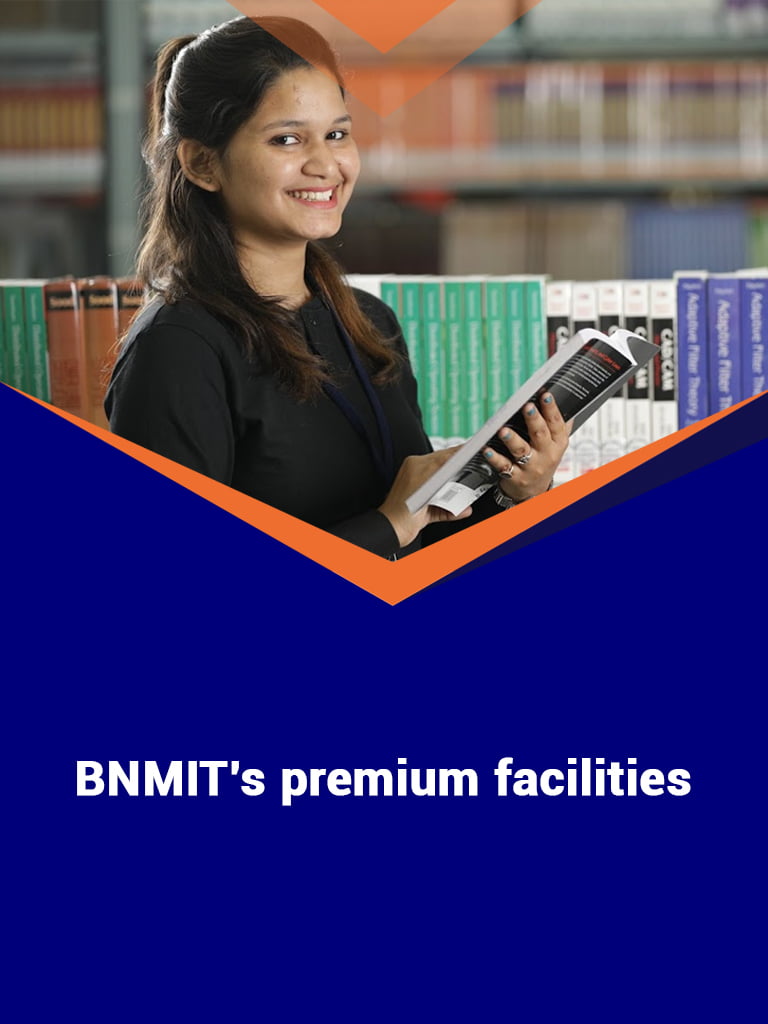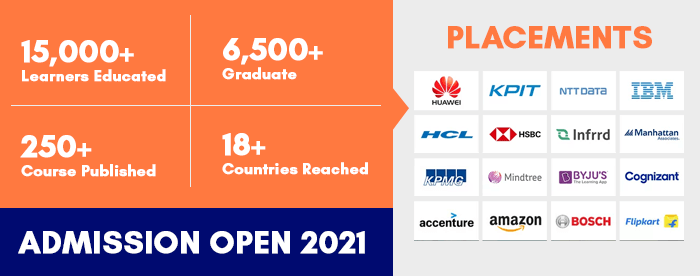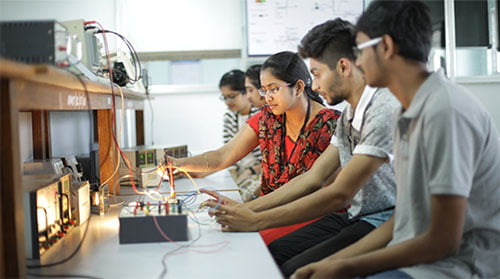
Analog Electronics Lab
Analog Electronics Lab provides an opportunity for students to conduct analog circuit experiments using discrete active and passive electronic devices. The lab is well equipped with regulated power supplies, signal generators, and analog & digital oscilloscopes. Student utilise this lab to perform and understand the characteristics of diodes, junction and field transistors. Students design, rig up and analyse the working of transistorised circuits such as amplifiers, oscillators and voltage regulators. Apart from the prescribed experiments, the lab provides an opportunity for students to perform additional experiments such as verification of simple network theorems and op-amp based circuits. Further, students use this lab to implement circuits for real world application.
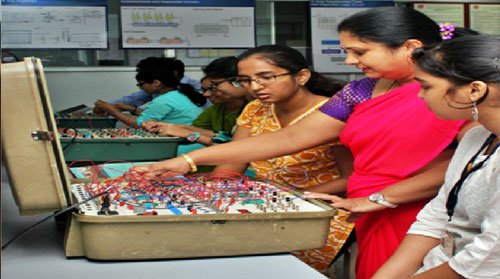
Digital Electronics Lab
Digital Electronics laboratory provides a fundamental platform to learn function and application of hardware components and ICs for different combinational and sequential digital circuits. The lab is well equipped with Digital IC trainer kits where students rig up circuits like adder, subtractor, multiplexers, decoders, flip flops, shift registers, counters and sequence generators and verify them. With the objective of providing simulation facilities for complex digital hardware, the laboratory is provided with TINA simulation software. Students utilise the laboratory for identification of different ICs. This laboratory provides a fundamental platform in a variety of Hardware Description Language, Microprocessors and Embedded Systems, Implementation of Digital Hardware using FPGA and CPLDs. Real life application projects using gate level circuits can be implemented in this laboratory.
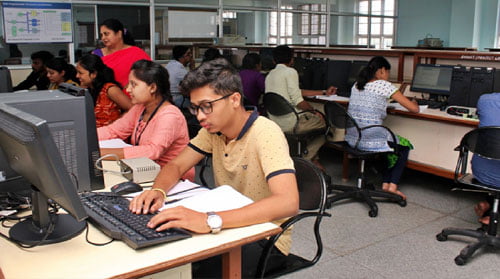
Microprocessor lab
Microprocessor laboratory facilitates students to develop assembly language programming skills for 8086. This has PCs loaded with MASM software, which is an assembler for 8086 programs. Students will write and execute 8086 assembly level programs to perform data transfer, arithmetic and logical operations, search elements in a given array, perform string transfer, string reversing, searching a character in a string and uses procedures and macros. Students will also be able to interface 8086 processor with various peripheral devices for different applications such as stepper motor control, DC motor control, ADC, DAC, LDR, Logic Controller, Keyboard and Seven segment displays. Experiments such as LCM/GCD/Square root etc. are executed beyond syllabus. Program and hardware can be developed using 8086 instructions for all real life application project.
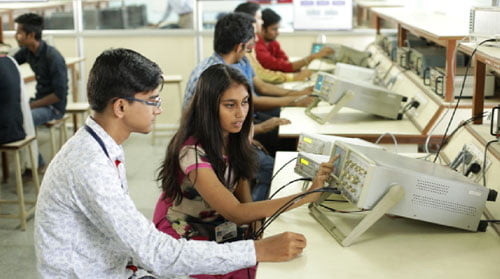
Linear ICs and Communication Lab
Linear ICs and Communication laboratory course enable students to design, demonstrate and analyse instrumentation amplifier, RC Phase shift and Wein bridge oscillators using Op-amp, Butterworth low pass and high pass filters, 4 bit R- 2R Op-Amp Digital to Analog Converter, Adder, Integrator and Differentiator using Op-Amp, Monostable and Astable Multivibrator using 555 Timer, Pulse sampling, flat top sampling and reconstruction, Amplitude modulation using transistor/FET, Frequency modulation using IC 8038/2206 and demodulation, BJT/FET Mixer, DSBSC generation using Balance Modulator IC 1496/1596 and Frequency synthesis using PLL The important facilities in this lab are Cathode Ray Oscilloscopes, Signal generators, Digital storage oscilloscopes, Op amp Tester, Dual Regulated power supply , Digital multi meter, Decade resistor box , Decade capacitor box , Decade inductor box , LCR Meter & Digital Ammeters. Students can conduct experiments on Schmitt trigger and Comparator which are beyond syllabus. Further sensor based experiments can be conducted for real application projects.
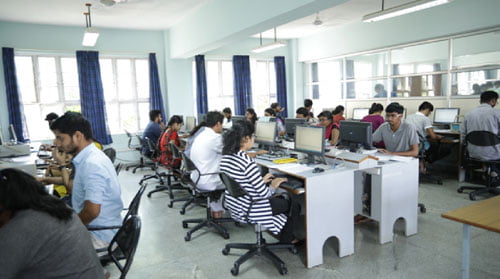
DSP Lab
Digital Signal Processing (DSP) Lab has Texas Instruments DSP kits for carrying out various signal processing experiments. The major software facilities include MATLAB and Code Composer Studio. Students execute various programs such as verification of sampling theorem, linear and circular convolution , auto and cross correlation, solving a given difference equation, computation of N point DFT, verification of DFT properties, IIR filter, DFT computation of square pulse and Sinc function etc. using MATLAB and in hardware. In addition to the above mentioned experiments, students will also conduct experiments to learn beyond the scope of university syllabus. Some of these experiments include the design of FIR and IIR filters for removing noise from real time signals, developing GUI in MATLAB for filters and other applications, analysing the spectral characteristics of speech signal using FFT, Speech recording and impact of sampling frequency on the signal.
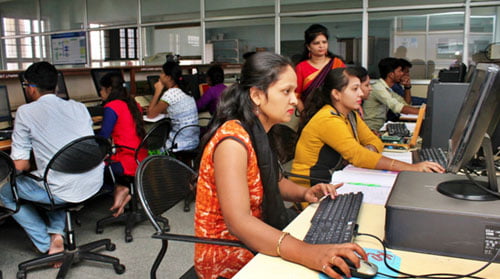
HDL Lab
Hardware Description Language (HDL) lab is equipped with Xilinx ISE 12.1 version for Simulation and FPGA synthesis software along with Universal multi vendor development kit with Spartan 6 – TQG144 daughter board. This lab is fully equipped and uses FPGA boards to interface peripheral hardware such as DC motor, Stepper motor, Hex Key pad, LCD, Seven segment displays and DAC. Basically the lab is meant to synthesise, simulate and implement Verilog and VHDL modules using different modelling styles for various combinational and sequential circuits. Further, Digital IP design and verification can also be done using the equipment. Actual chip details such as area, power and timing can be estimated with floor-plan and routing on the existing FPGA. Further, extended activities like real time sensing of data that can be converted to digital format can be processed with the available facilities. Real time controlling of engines and motors can be designed and tested. Digital signal processing algorithms can be modelled.
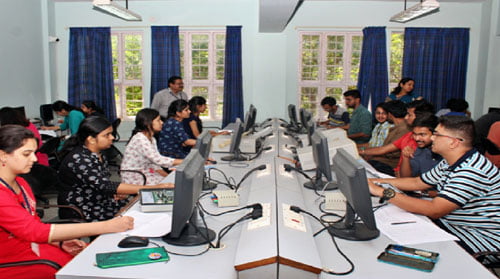
Embedded Controller Lab
Embedded Controller Lab aims to learn the software tool required for programming using Embedded C, interface external devices and I/O with ARM Cortex M3(LPC1768) and use the assembly instruction set for programming ARM Cortex M3 (LPC1768). This lab is fully equipped with efficient computer system,with Keil µVision IDE, Flash Magic tool, ARM CORTEX M3 based Evaluation boards, Power Supplies, USB cables and interfacing of I/O modules. Students conduct hardware and software experiments on Relay, Buzzer, LED, LCD, Stepper motor control, DC motor control, DAC, ADC, temperature controller, UART, 7-segment LED. PWM with varying duty cycle using ARM Cortex M3. This lab can be utilised for developing real life application projects like air quality monitoring and automated temperature control system etc. Experiments like generation of staircase, saw tooth waveform using DAC conducted, are beyond the syllabus.
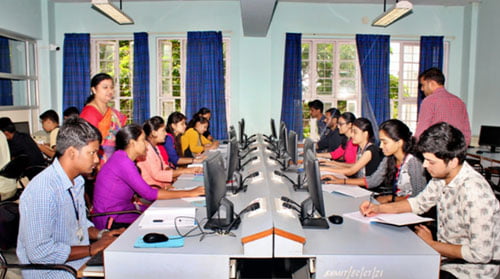
Computer Networks Laboratory
Computer Networks laboratory offers an integrated educational process in the field of information and communication technologies emphasising the issue of computer networks, their design, administration and management. Computer Networks laboratory is equipped with high-end systems to cater the needs of networking software. Visualisation of topologies in wired LAN and wireless LAN for evaluating the performance of networking protocols using network simulators like NS2 helps the students to get exposure to real time topologies. Algorithms are also studied by simulating the algorithms in C/C++ language. Apart from the curriculum experiments additional algorithms, Rlogin, Telnet and socket programming have been implemented by students to enhance their knowledge in networks. With these facilities, it is possible to develop projects by undergraduate and postgraduate students in networking to measure the performance of real time networks.
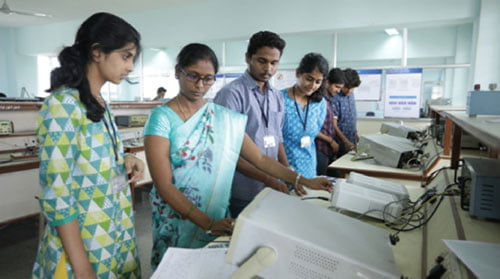
Advanced Communication Lab
The Advanced Communication Laboratory provides an opportunity for students to the design and verify the concepts of modern digital communication systems that operate frequency from MHz-GHz range. The lab includes experiments on applications of Digital coding and modulation techniques such as TDM of two band limited signals, ASK, FSK, PSK, DPSK, QPSK generation and detection, PCM generation and detection using a CODEC Chip, Fibre Optic Communication, Characteristics of microwave wave guide components and study of various Microstrip components and Microstrip antenna characteristics. The Microwave test benches are used to conduct experiments in GHz frequency range. An Optical Fibre kit is used to demonstrate communication and multiplexing through light waves to understand the various optical fibre losses that occur in real time. Apart from the prescribed experiments, the lab provides an opportunity to perform additional experiments on Microwave test benches to understand working of Directional couplers, Magic Tee etc.
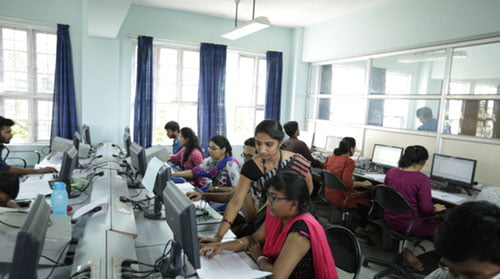
VLSI Lab
VLSI Lab is equipped with the industry standard EDA tool (UG & PG Bundle) from Cadence Design system. Students will explore the CAD tool and understand the flow of the Full Custom IC design cycle. Both analog and digital circuits designs are implemented in this Lab. Design of digital circuits, such as Inverter, Buffer, Transmission Gate, Flip flop, Serial & Parallel adder, counters and Successive Approximation Register are simulated. Verification using NC Sim tool, is carried out. DRC, LVS and Parasitic Extraction are carried out using cadence tools for analog design such as inverter, CS and CD amplifier, Op-Amp, R-2R DAC. The Pre layout and Post layout simulation are performed under virtuoso environment, tool -Assura supports the design rule check, layout versus schematic check and extraction of parasitic which are required for post layout simulation. The mixed signal simulations are performed using AMS Designer.
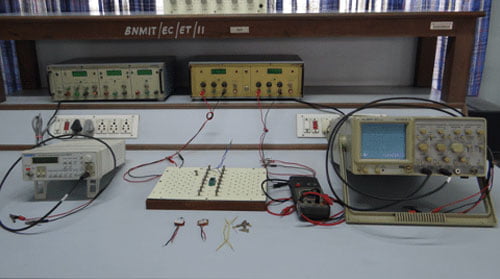
Electronics devices and Instrumentation lab
Electronics devices and Instrumentation lab facilitates the student to learn about the active and passive electronic devices and instruments by simulation and practically carrying out the experiment. The lab is equipped with regulated power supplies, signal generators, Oscilloscopes. In this lab, students learn about applications of diode like Clipper, Clamper, Rectifiers, Zener Diode, Photodiode, Light Dependant Resistor, Thermistor and also the characteristics of MOSFET, BJT, JFET, SCR, Zener diode. They also learn about the instruments to measure resistance using Wheatstone bridge and Kelvins double bridge, measure temperature using thermistor, design regulated power supply using Zener diode and series pass transistor. This lab will help students to understand the working of different electronic devices, its characteristics and application
Department Library
The department has a Library for staff and students, which includes reference books, university question papers, seminar and project reports.
| Sl. No | Particulars | Quantity |
|---|---|---|
| 1 | Total Number of Book Titles | 678 |
| 2 | Total Number of Book Volumes | 720 |
| Sl. No | Books | Quantity | |
|---|---|---|---|
| Total number of titles | Total number of volumes | ||
| 1 | I Year | 64 | 70 |
| 2 | II Year | 262 | 280 |
| 3 | III Year | 264 | 276 |
| 4 | IV Year | 88 | 94 |
| Sl. No | Particulars | Quantity |
|---|---|---|
| 1 | Total Number of M.Tech Project Reports | 43 |
| 2 | Total Number of Ph.D. Thesis | 5 |
Well Equipped Class Rooms
Class rooms have projectors, RDPs, smart boards & facility for virtual classes.


